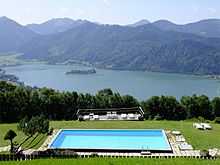Schliersee
| Schliersee | ||
|---|---|---|
| ||
 Schliersee | ||
Location of Schliersee within Miesbach district  | ||
| Coordinates: 47°44′N 11°52′E / 47.733°N 11.867°ECoordinates: 47°44′N 11°52′E / 47.733°N 11.867°E | ||
| Country | Germany | |
| State | Bavaria | |
| Admin. region | Oberbayern | |
| District | Miesbach | |
| Government | ||
| • Mayor | Franz Schnitzenbaumer (CSU) | |
| Area | ||
| • Total | 79.16 km2 (30.56 sq mi) | |
| Population (2013-12-31)[1] | ||
| • Total | 6,784 | |
| • Density | 86/km2 (220/sq mi) | |
| Time zone | CET/CEST (UTC+1/+2) | |
| Postal codes | 83727 | |
| Dialling codes | 08026 | |
| Vehicle registration | MB | |
| Website | www.schliersee.de | |
- For Schliersee-Neuhaus, see Schliersee-Neuhaus. For the lake, see Lake Schliersee.
Schliersee is a small town (Markt) and a municipality in the district of Miesbach in Bavaria in Germany. It is named after the nearby Lake Schliersee.
Among the points of interest in Schliersee, a climatic health resort, is the St Sixtus church with a Holy Trinity group by Erasmus Grasser and wall and ceiling frescoes by Johann Baptist Zimmermann. The excellent quality of the water in the Schliersee is due in large part to the construction of a system for purifying waste water from the area surrounding the lake, which was supported by the state of Bavaria with large subsidies and low-interest loans.
| ||||||||
References
- ↑ "Fortschreibung des Bevölkerungsstandes". Bayerisches Landesamt für Statistik und Datenverarbeitung (in German). 31 December 2013.

Schliersee
